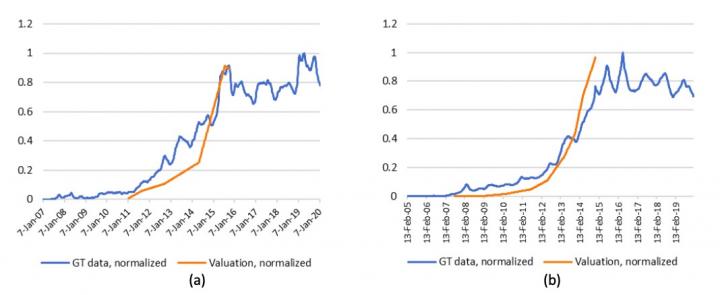
Credit: Malyy et al., 2021
Skoltech researchers used Google Trends’ Big Data ensuing from human interactions with the Internet to develop a new methodology – a tool and a data source – for analyzing and researching the growth of startups. A paper reporting these important findings was published in technology management journal, Technological Forecasting and Social Change.
Startups and high-growth technology-based ventures they transform into are regarded as the key drivers of economic development, innovation, and job creation on the national and global level. However, despite their crucial importance for the economy and high interest from researchers and policy-makers, startups display growth patterns that are difficult to analyze. These fragile, early-stage private businesses, which may quickly scale up, do not have time, interest, or obligation to share much data about what they achieved, when, or how. Thus, to outside observers, startups look like “black boxes” whose progress can hardly be assessed due to a lack of objective information.
Maksim Malyy, a PhD student from the Skoltech Center for Entrepreneurship and Innovation (CEI), has been intrigued by this problem since he worked in a startup accelerator in St. Petersburg before joining Skoltech. Looking into theoretical and practical aspects of the problem for the last three years, Maksim, his supervisor, professor Zeljko Tekic, and Skoltech assistant professor Tatiana Podladchikova came up with valuable insights on how to deal with the data scarcity problem in studying startups. Some of their findings were published in the paper.
Maksim explains why this research is so important: We demonstrate that web-search traffic information, in particular Google Trends data, can serve as a valuable source of high-quality data for analyzing the advancement of startups and growth-oriented technology-based new ventures they evolve into. We analyzed a large and transparently selected set of US based companies and showed the existence of a strong correlation between the curves based on Google searches by company name and those depicting valuations achieved through a series of investment rounds.
According to the authors, this correlation enables using Google Trends data as a proxy measure of growth instead of non-public and rarely available measures like sales, employee and market share growth. Google Trends data, which are public, easy to collect and available for almost any company since its inception, can help in building more accurate and even real-time data-driven growth paths for startups. With these evolution curves, one could revisit some old answers, ask new questions, and come up with more solid concepts, theories, and predictions.
Maksim believes that this study has strong implications for start-up research: Our findings suggest that for startups, especially thriving unicorns or B2C digital platforms, the proposed approach may become an equivalent of an X-ray scan, offering a cheap, easy, and non-invasive way to understand the workings of a technology-based new venture.
By way of comment, professor Tekic and professor Podladchikova cite a report by one of the reviewers: “I think this paper will stand the test of time and be useful for many years to come. It truly is a fascinating study.”
###
Media Contact
Ilyana Zolotareva
[email protected]
Original Source
https:/
Related Journal Article
http://dx.




